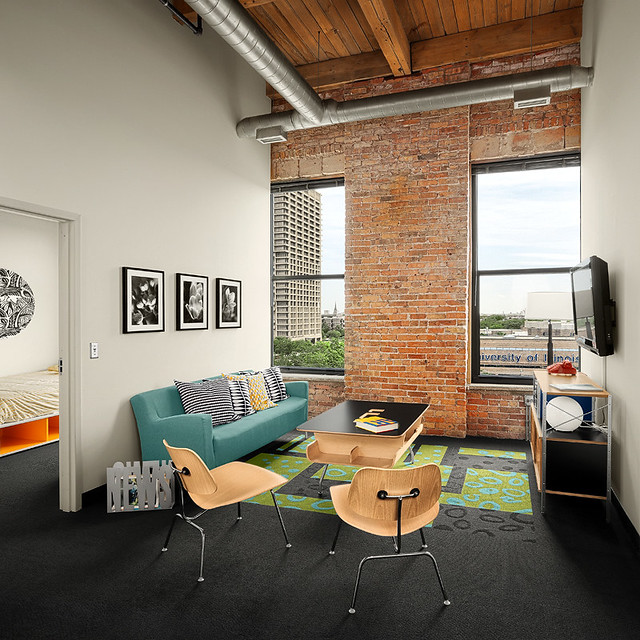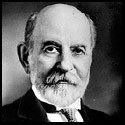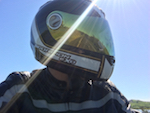|
Cards like this: used in viewers like this: 
|
|
|
|

|
| # ? Apr 19, 2024 01:05 |
|
Filter question, I recently got a 2 stop ND filter and on overcast days or in the shade its great for making long exposures but its not usually enough in bright sun. I was thinking about a variable ND filter and was wondering if they are worth the extra money.
|
|
|
|
Ezekiel_980 posted:Filter question, I recently got a 2 stop ND filter and on overcast days or in the shade its great for making long exposures but its not usually enough in bright sun. I was thinking about a variable ND filter and was wondering if they are worth the extra money. Variable nd's are usually a video thing to maintain SS/aperture in changing light. The IQ out of them is not that great for stills unless you buy the 400$ Singh Ray one. Just get an ndx400 if you want a screw in, or a big stopper if you have lee drop ins.
|
|
|
|
It's much easier to make a set of ND filters (2 and 4 stop seem pretty common) that don't mess with colours too much and don't have any weird distortions or unevenness than it is to make a variable ND with similarly high optical quality. I have a cheap variable ND and it's a fun toy but I wouldn't use it for any photograph I really cared about. Pick up a 4-stop to go with your 2 and stack them.
|
|
|
|
I work in and around contemporary art and I'm interested in interior photography, specifically the interiors of exhibitions. As an academic pursuit (my research and specialties on the academic side are about exhibition design and history), an excuse to spend more time in galleries that will have me and maybe a professional sideline at some point. I've been taking camera phone photos in and around the exhibition I've been working on lately with the intent of doing a little photo and I'm really pleased with how they turned out, I'd like to start looking into how to do it properly. I'm not skilled as such but I'm completely competent with a DSLR in normal circumstances but I've never used a tripod before or taken anything other than snapshots. I have a rough knowledge of how cameras function and I'm very technically minded. Now where the gently caress do I start? Is there a go-to text for architectural/interior photography? Do you know anybody who does similar? Etc. I know I'll need a tripod and some particular lenses. Even good people to look at in this line of photography would be helpful.
|
|
|
|
Search for "woot fatigue".
|
|
|
|
Anyone have an idea of a reputable place to get c-26 film developed? My fiancee found an old toy camera that belonged to her dad. Figure it likely won't turn out, but worth a shot.
|
|
|
|
Whirlwind Jones posted:Search for "woot fatigue".
|
|
|
|
TequilaJesus posted:Anyone have an idea of a reputable place to get c-26 film developed? My fiancee found an old toy camera that belonged to her dad. Figure it likely won't turn out, but worth a shot. These guys might be worth a shot: http://www.filmrescue.com/old-still-film-developing/
|
|
|
|
rorty posted:I work in and around contemporary art and I'm interested in interior photography, specifically the interiors of exhibitions. As an academic pursuit (my research and specialties on the academic side are about exhibition design and history), an excuse to spend more time in galleries that will have me and maybe a professional sideline at some point. I've been taking camera phone photos in and around the exhibition I've been working on lately with the intent of doing a little photo and I'm really pleased with how they turned out, I'd like to start looking into how to do it properly. Super wide lenses, tilt shift / perspective control lenses, gelling lights, adding flashes to the scene to supplement or override the existing light, panoramic stitching, and, if you're feeling crazy, masking out and adjusting individual parts of the scene in Photoshop to have control over every aspect of the image.
|
|
|
|
dakana posted:Super wide lenses, tilt shift / perspective control lenses, gelling lights, adding flashes to the scene to supplement or override the existing light, panoramic stitching, and, if you're feeling crazy, masking out and adjusting individual parts of the scene in Photoshop to have control over every aspect of the image. Seriously, take a picture of a typical house interior, like a living room tastefully decorated and nicely lit. Imagine that photo took several hours to shoot, with lots of test shots, light metering, adjustments, waiting for just the right daylight coming through that window, etc. Now select every single loving thing in that image - the bowl on the coffee table, the lightswitch, each key on the piano - and agonize over the levels on each and every layer to create EXACTLY the scene you want. I'm pretty sure he's better now, last year he raised a family of baby raccoons and that seems to have helped. That, and the Porsche.
|
|
|
|
I'm pretty sure he had a collection of specific lightbulbs that he replaced everything in room with before taking the shots too.
|
|
|
|
I remember that post, when he printed film he would meticulously cut out cardboard masks of every individual shape of whatever he had shot. Meanwhile I'm like, photoshop?
|
|
|
|
I clearly need to get an archives upgrade
|
|
|
|
Woot Fatigue: Lemme show you how to max out layers in PS.
|
|
|
|
http://forums.somethingawful.com/showthread.php?threadid=3227180&userid=114841#post370694612
|
|
|
|
Thanks for finding it! Too bad the photos are gone from flickr :<
|
|
|
|
MrBlandAverage posted:http://forums.somethingawful.com/showthread.php?threadid=3227180&userid=114841#post370694612  That is a special kind of crazy. That is a special kind of crazy.
|
|
|
|
rawrr posted:Thanks for finding it! Too bad the photos are gone from flickr :< It's still there, but probably just updated at some point and the link broke.  AUTOMATIC LOFTS by Brad Gillette, on Flickr EDIT: The screenshot one is gone though. William T. Hornaday fucked around with this message at 19:03 on Jul 21, 2014 |
|
|
|
William T. Hornaday posted:It's still there, but probably just updated at some point and the link broke. There's some uncanny valley poo poo happening here
|
|
|
|
That's not his best one, some the later stuff he posted is pretty much perfect.
|
|
|
|
Yeah, don't let appearances of insanity from a few years ago distract you from the fact that Woot Fatigue is a really excellent photographer. The man can put together a photo that will make money gush from one bank account to another. That's an extremely useful skill.
|
|
|
|
And if you follow his IG you get to see what he spends it on. 
|
|
|
|
xzzy posted:That's not his best one, some the later stuff he posted is pretty much perfect. cocaine is a helluva drug.
|
|
|
|
ExecuDork posted:I was going to agree with this (FRICKIN' LASERS!!!) but then I found a great way to save money: As an update, Lastolite released a whole mess of these things: http://www.lastolite.us/out_of_focus_backgrounds
|
|
|
|
I get that you'd like to be able to take an outdoors-looking shot in the studio, but man those images look so fake.
|
|
|
|
Could someone please dumb down this paragraph about 18% reflectance? The part about seeing in black and white. I don't really understand what that means. Your camera’s light meter (whether center-weighted, matrix/ evaluative, or spot) does not “see” the world in either living color or black and white but rather as a neutral gray. In addition, your reflected-light meter is also calibrated to assume that all those neutral-gray subjects will reflect back approximately 18% of the light that hits them.
|
|
|
|
huhu posted:Could someone please dumb down this paragraph about 18% reflectance? The part about seeing in black and white. I don't really understand what that means. Your camera doesn't see colors. It sees how much light is in the scene, and your camera wants to make everything sorta grey. If it is black, your camera light sensor wants to make it grey, so you need to FORCE it to underexpose so it shows up black. If it is white, your camera wants to make it grey so you need to FORCE it to overexpose so it shows up white. Those are the extremes and the very basics. You can then look at a scene like a forest scene, and think "Oh, this scene is darker than grey, so I want to underexpose from what my camera says so that it looks right". edit: This is the grey that your camera wants to make everything.  If your scene is lighter than that, your camera will darken the scene and it won't be a "correct" interpretation of the scene. If your scene is darker than that, your camera will lighten the scene and it won't be "correct". Try this out: take a picture of a piece of printer paper in Program mode so that it fills the frame, and compare the image on your camera to the paper in real life. Hokkaido Anxiety fucked around with this message at 16:12 on Jul 27, 2014 |
|
|
|
I am by no means a pro but this is my understanding: Basically it's saying that the camera's light meter is calibrated in such a way that when perfectly balanced/centered, the amount of light entering the camera (bounced off the scene you're shooting and onto the sensor) is the equivalent to if the scene was just purely 18% of the way to completely dark/black (from pure white/blank). Google around for 'grey cards' and what principle they're based on for further explanation. Alternatively, take a photo of a clean white surface and also a pure black surface and you'll find, if metered to dead center, they'll both be the exact same shade of grey (18%). Imagine taking one of your shots, making it black and white, then blending it all together until it is completely uniform in shade. That shade, if your shot was perfectly centered via your light meter, would be 18% grey. e:fb
|
|
|
|
The camera's light meter is effectively averaging the intensity of light hitting every pixel on the sensor (ie, a histogram) and comparing it to a reference value (which is the 18% grey). If the average is less than the reference, it suggests a longer exposure. If the average is higher, it suggests a shorter. For creative reasons the photographer may not want a perfectly balanced scene, so it's up to you to develop the experience to interpret what the camera is telling you.
|
|
|
|
That said, meters do a whole goddamn lot more than that in newer cameras. That's still how it works at a basic level though. Most decent ones have a massive bank of "common scenes" (because most people aren't all that creative), so they try to match what the meter sees (which actually does see in color, and is more of a tiny imaging sensor than a light meter), work out what it is you're trying to do, and apply a metering profile that will get you the result you want.
SoundMonkey fucked around with this message at 22:00 on Jul 27, 2014 |
|
|
|
timrenzi574 posted:Variable nd's are usually a video thing to maintain SS/aperture in changing light. The IQ out of them is not that great for stills unless you buy the 400$ Singh Ray one. Just get an ndx400 if you want a screw in, or a big stopper if you have lee drop ins. I've never seen anyone use a variable ND to control exposure like that. Most people use them because you're stuck to 180 degree shutter in video and nobody makes an ISO 25 camera so you need a ridiculous amount of ND just to shoot at f2. For video I like the Heliopan one.
|
|
|
|
1st AD posted:I've never seen anyone use a variable ND to control exposure like that. Most people use them because you're stuck to 180 degree shutter in video and nobody makes an ISO 25 camera so you need a ridiculous amount of ND just to shoot at f2. I stand corrected. I assumed people must want the variable functionality to be able to adapt else they'd buy a really dark fixed one.
|
|
|
|
Some cameras like the Alexas and the Blackmagics have a native ISO of 800 and if you want to maximize your headroom in the shadows and highlights you'd need to be able to quickly adjust exposure for different scenes and lenses.
|
|
|
|
Is the Canon 70-200 F2.8 II really worth another grand on top of the Tamron or Sigma offerings? I'm not a professional, so I'm leaning towards it not being worth the upgrade for my use case. Does anyone have a take on the Tamron versus Sigma?
NeuralSpark fucked around with this message at 19:50 on Jul 30, 2014 |
|
|
|
NeuralSpark posted:Is the Canon 70-200 F2.8 II really worth another grand on top of the Tamron or Sigma offerings? I'm not a professional, so I'm leaning towards it not being worth the upgrade for my use case. Does anyone have a take on the Tamron versus Sigma? I've been wondering the same thing. It looks like the tamron is generally considered slightly better. It is also slightly more expensive, but you do get a 6 year warranty.
|
|
|
|
NeuralSpark posted:Is the Canon 70-200 F2.8 II really worth another grand on top of the Tamron or Sigma offerings? I'm not a professional, so I'm leaning towards it not being worth the upgrade for my use case. Does anyone have a take on the Tamron versus Sigma? Here is a solution. Rent them all. You forget the resale value of lenses is better than the resale value of bodies. You may throw 2200bux today, but in 4 years you can probably get 1800ish. Do not expect the tammy/sigma to retain value in the same manner.
|
|
|
|
NeuralSpark posted:Is the Canon 70-200 F2.8 II really worth another grand on top of the Tamron or Sigma offerings? I'm not a professional, so I'm leaning towards it not being worth the upgrade for my use case. Does anyone have a take on the Tamron versus Sigma? There is no Pentax-brand 70-200/2.8 currently, but the Sigma and Tamron offerings are available for Pentax so PentaxForums did a head-to-head comparison of them. Obviously that doesn't provide any input to your question about the relative value of the Canon, but it might give you some ideas for things to look for / compare if you have a chance to play with any of those lenses. Their overall conclusion: Pentaxforums posted:If you are not on a tight budget, the Sigma is a better choice over the Tamron as it has superior handling
|
|
|
|
Stregone posted:I've been wondering the same thing. It looks like the tamron is generally considered slightly better. It is also slightly more expensive, but you do get a 6 year warranty. That seems to be the consensus - the Tamron is a better picture but the Sigma has a nicer build and better AF. Musket posted:Here is a solution. Rent them all. You forget the resale value of lenses is better than the resale value of bodies. You may throw 2200bux today, but in 4 years you can probably get 1800ish. Do not expect the tammy/sigma to retain value in the same manner. Yup, I'm renting the Canon for a few days next week.
|
|
|
|

|
| # ? Apr 19, 2024 01:05 |
|
NeuralSpark posted:Yup, I'm renting the Canon for a few days next week. You're hosed. As soon as you use that lens you're gonna convince yourself it's worth the $$
|
|
|





























